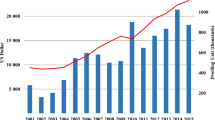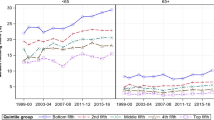Abstract
In this study, the ordered logistic regression model indicates that renters suffer a greater housing cost burden than homeowners and that the lower the income of the household, the larger the portion of income that is spent for housing. Further, the model also shows that the burden of high housing costs falls disproportionately on certain groups of American households. Compared to the reference group, two single-risk groups (Asian-American households and households with three or more children) and two dual-risk groups (female-headed households with three or more children and minority households with three or more children) tend to have a higher risk of excessive housing costs. Elderly households and three elderly-related groups (female-headed elderly households, minority elderly households, and female-headed minority elderly households), however, tend to have a lower risk of housing cost burden than other households. The housing cost burden of the reference group is comparable to the housing cost burden of each of the following groups: for single female-headed households; Black households; Hispanic households; and female-headed minority households. The policy implications of these findings are discussed in the paper.
Similar content being viewed by others
References
Apgar, W. C. Jr., DiPasquale, D., Cummings, J., & McArdle, N. (1990). The state of the nation's housing 1990. Cambridge, MA: Joint Center for Housing Studies, Harvard University.
Appelbaum, R. P. (1989). The affordability gap. Society, 26(4), 6–8.
Chi, P. S. K., Laquatra, J., & Park, H. W. (1991). Identifying American households at risk of housing problems. In E. G. Goetz, S.Y. Khil, and E. W. Morris (Eds.), Social science research on housing. (pp. 1–22). St. Paul, MN: University of Minnesota.
Gilderbloom, J. I., & Appelbaum, R. P. (1988). Rethinking rental housing. Philadelphia: Temple University Press.
Golant, S. M., & La Greca, A. J. (1995). The relative deprivation of U.S. elderly house-holds as judged by their housing problems. Journal of Gerontology, 50B(1), S13–S23.
Haddon, L., & Leger, M. (1989, April) Codebook for the annual housing survey data base. Cambridge; MA: Abt Associates, Inc.
Housing Assistance Council, Inc. (1987). Rural housing and poverty monitor. Washington, DC: Author.
Johnson, A. K. (1989). Female-headed homeless families: A comparative profile. Affilia, 4(4), 23–39.
Kingsley, G. T., & Struyk, R. J. (1991). Housing policy in the United States: Trends, future needs, and implications for congregate housing. Journal of Housing for the Elderly, 9, 39–56.
Lerman, D. L., & Reeder, W. J. (1987). The affordability of adequate housing. AREUEA Journal, 15(4), 389–404.
Myers, D. (1984). Turnover and filtering of postwar single-family houses. APA Journal, 50(3), 352–358.
Prindle, W. R., & Reid, M. W. (1988). Preparing for the energy challenges of the 1990s, energy efficiency: A key to affordable housing. Washington, DC: The Alliance to Save Energy.
SAS Institute, Inc. (1983). SUGI supplemental library user's guide. Cary, NC: Author.
Schuchardt, J., & Guadagno, M. A. N. (1991). A comparison of lower middle income two-parent and single-mother families. Family Economics Review, 4(2), 9–17.
Schwenk, N. E. (1991). Trends in housing. Family Economics Review, 4(1), 14–19.
Stone, A. (1989). WREI fact sheets on women and housing. Washington, DC: Women's Research and Education Institute.
Stone, M. E. (1990). One-third of a nation: A new look at housing affordability in America. Washington, DC: Economic Policy Institute.
U.S. Bureau of the Census & Bureau of Labor Statistics. (1989a). The consumer expenditure survey, consumer spending update (Vol. 1,No. 1). Washington, DC: U.S. Government Printing Office.
U.S. Bureau of the Census & Bureau of Labor Statistics. (1989b). The consumer expenditure survey, consumer spending update (Vol. 1,No. 2). Washington, DC: U.S. Government Printing Office.
U.S. Bureau of the Census & Bureau of Labor Statistics. (1990). The consumer expenditure survey, consumer spending update (Vol. 2,No. 1). Washington, DC: U.S. Government Printing Office.
U.S. Congress. Congressional Budget Office. (1994, December). The challenges facing federal rental assistance programs. Washington, DC: Government Printing Office.
Vidal, A. C. (1990). A community-based approach to affordable housing. The New School Commentator, 2(2), 1–4.
Author information
Authors and Affiliations
Rights and permissions
About this article
Cite this article
Chi, P.S., Laquatra, J. Profiles of Housing Cost Burden in the United States. Journal of Family and Economic Issues 19, 175–193 (1998). https://doi.org/10.1023/A:1022952824457
Issue Date:
DOI: https://doi.org/10.1023/A:1022952824457




